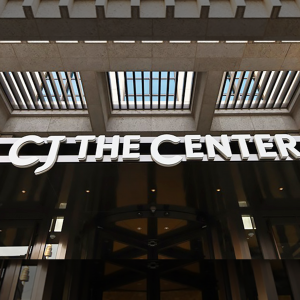CJ CGV reshapes Korean cinema landscape with its revolutionary multiplexes, providing new technology and immersive experiences

“The sound systems, projection quality and seating appear to need improvement. Korean theaters should transition to multiplexes that include amenities like restaurants and shopping centers.”
In October 1995 when Steven Spielberg made his inaugural visit to Korea, he offered a critical assessment of the country’s film infrastructure.
At that time, the country was primarily characterized by “single-screen theaters,” where each venue screened only one movie at a time. Given the rigid nature of the moviegoing experience, there were many instances of ticket scalping, and the cramped seating arrangements often hindered the viewing experience. This infrastructure contributed to a decline in audience attendance, with the number of moviegoers dropping from 8 million in 1990 to 5 million in 1998.
In contrast, the U.S. had already introduced multiplex theaters featuring more than 20 screens in the 1980s, creating a nationwide boom. In the U.K., the number of movie audiences doubled within just seven years following the introduction of multiplex theaters.
Breaking New Ground at Every Stage
While the need for multiplexes was evident in Korea, the emergence of new technologies like the internet made traditional theater allure obsolete. Building new multiplex theaters required considerable space, and due to the high land costs in Korea, expenses surged to more than double compared to single-screen theaters.
Despite these challenges, CJ remained steadfast in its conviction that multiplexes formed the bedrock infrastructure for advancing the domestic film industry. In June 1995, the company’s Multimedia Business Division established a dedicated theater team, initiating a comprehensive planning process for the inception of Korea’s inaugural multiplex theater, commencing the journey of CJ CGV, the nation’s first multiplex.
As anticipated, the construction of multiplex cinemas presented a host of challenges. Each phase of the endeavor marked uncharted territory. The outbreak of the IMF foreign exchange crisis during construction substantially escalated costs. Other prominent players in the film industry hesitated to proceed. But CJ forged ahead, recognizing the pivotal role of multiplex theaters as indispensable infrastructure for the film sector.
The Rise of the Multiplex Era in Korea

On April 4, 1998, CGV Gangbyeon11 officially opened its doors in Seoul’s Gwangjin-gu district, marking the dawn of the multiplex era in Korea. Spanning a total area of approximately 5,000 square meters, with 1,922 seats across 11 screens, it became the largest theater nationwide. Directly connected to Gangbyeon subway station and surrounded by a shopping center, it was anticipated to attract a significant flow of moviegoers, particularly within the key demographic of 10 to 20-year-olds.
The CGV Gangbyeon11 emerged as a new cultural space distinct from traditional single-screen theaters. Equipped with a 24-hour computerized Automatic Response System (ARS) for easier reservations, state-of-the-art Dolby surround sound setup, updated screening schedules, spacious seats with cup holders and even noiseless popcorn packaging, the new theater offered a revolutionary moviegoing experience.
CGV, The Premier Recreational Destination
CGV’s growth trajectory was nothing short of remarkable. In its first year, the theater drew in a staggering 3.5 million viewers. While theaters in Seoul were facing struggles at the time, CGV Gangbyeon alone boasted nearly double the occupancy rates. Such impressive metrics led the prominent U.S. entertainment magazine Variety to dub CGV as “Asia’s most ambitious cinema operator.”
As the 2000s loomed, CGV’s expansion continued to gain more momentum. This period witnessed the adoption of the five-day workweek system, accompanied by a rise in disposable income, fostering a heightened desire for an enhanced quality of life. While the existing recreational spaces fell short of meeting this burgeoning demand, CGV multiplex theaters, with their accessible, affordable, and inviting ambiance, naturally emerged as the nation’s premier recreational destination.
While numerous major corporations tried to emulate the success of CJ’s multiplex business, many withdrew before the turn of the millennium. CJ continued to expand its business, debuting CGV Incheon14, its second multiplex branch boasting 14 screens, in December 1999. In February 2003, the company opened its Suwon location, surpassing 100 screens just five years after the launch of the first branch and paving the way for subsequent branches in other locations nationwide.

As the patronage at CGV grew, CJ continued to expand its screen count to cater to a broader audience. By 2003, by the time CGV opened 100 screens, the brand had already amassed over 70 million viewers cumulatively, eventually surpassing 100 million within a year.
Introducing cutting-edge features such as IMAX, 3D, 4DX and ScreenX theaters, alongside premium experiences like Gold Class and Cine de Chef, CGV has attracted a broader demographic, appealing to those previously less inclined to partake in cinema outings.
The brand recognition of CGV reached such heights that competitors are still striving to attain comparable success in terms of theater count or market share.
The “Golden Age” of Korean Cinema
At the dawn of the 2000s, Korean cinema embarked on its golden era, with the emergence of the first Korean film to exceed 10 million viewers, as well as directors like Im Kwon-taek and Park Chan-wook recognized at the globally esteemed events such as the Cannes Film Festival. By the late 2000s, CGV held prominent shares within a saturated Korean market.
Not being complacent, CGV continued to innovate and differentiate itself. During this period, the company recognized the emerging trend of “digital cinema,” which used digital projection rather than analog equipment to address concerns such as cost, processing time and image quality degradation associated with traditional film. CGV pioneered the adoption of digital projection technology, introducing it to the Korean film “Who’s Got the Tape” in 2004, and equipping their Yongsan branch with digital projection systems.

Moreover, the inclusion of IMAX theaters drew in a surge of fresh patrons. IMAX Corporation in Canada, after recognizing CGV’s vision and competitiveness, pursued an exclusive deal which resulted in the transformation of several CGV screens into IMAX theaters, with each renovation costing around 3 billion KRW (about 2.2 million USD).
The debut IMAX showing of “Harry Potter and the Goblet of Fire” in December 2005 was met with explosive acclaim, achieving record-breaking attendance rates within just five days of ticket sales opening and surpassing standard screenings by more than eightfold.
Developing Immersive Viewing Experiences with 4DX and ScreenX

CGV’s innovative offerings developed in-house mark a pioneering achievement in the global cinema landscape. As of the first half of 2023, these advanced technologies, comprising 4DX, ScreenX and 4DXScreen, are integrated into 1,152 theaters spanning 73 countries.
CGV’s unique cinematic experience was redefined with the world’s first 4DX theater, which was inaugurated at CGV Sangam in 2009. In the 4DX theater, audience chairs synchronize with on-screen action, delivering an immersive multi-sensory cinematic experience. Despite limited screenings, the occupancy rate skyrocketed to over 90%, surpassing double that of traditional screenings.
In 2013, CGV followed up with the development of ScreenX, which projected on three walls, including the main screen and both side walls. This innovative approach provided a multidimensional and immersive viewing experience, establishing ScreenX as the world’s premier multi-sided screening venue.
ScreenX’s success was demonstrated by acclaimed films like “The X” (2013) directed by Kim Jee-woon, “Coin Locker Girl” and “The Priests.” In terms of the technology itself, films such as “The Himalayas” effectively leveraged ScreenX’s capabilities by portraying vast snowy landscapes in a captivating way. Moreover, “Train to Busan,” which debuted in ScreenX format in 2016, adeptly utilized the format’s immersive features to heighten tension and excitement, with zombies appearing from every angle.
ScreenX and 4DX continued to remain relevant into 2022. “Top Gun: Maverick,” which represented the epitome of 4DX technology, achieved a box office revenue of 22 million USD. This film further bolstered the popularity of CGV’s specialized theaters, particularly locations with IMAX or ScreenX theaters.
Pioneering a New Paradigm for Theaters


In regard to the number of moviegoers, CGV achieved a remarkable milestone with its record-breaking attendance in 2019. However, the cinema sector has encountered a multitude of hurdles since late 2019, triggered by the advent of the COVID-19 pandemic. Prolonged social distancing measures in South Korea, disrupted the traditional communal experience of moviegoing. Additionally, the rapid expansion of the Over-The-Top (OTT) streaming platform industry has introduced fresh complexities to the cinema landscape.
As the country’s leading cinema operator, CGV is transitioning from a conventional venue, traditionally termed “multiplex,” to a “lifestyle venue” aligning with evolving trends in the movie industry. By repurposing movie theaters into sports climbing gyms branded as “PEAKERS” and providing alternative content for cinema screens, CGV demonstrates its commitment to constant innovation and self-improvement, pushing boundaries for continuous growth.











